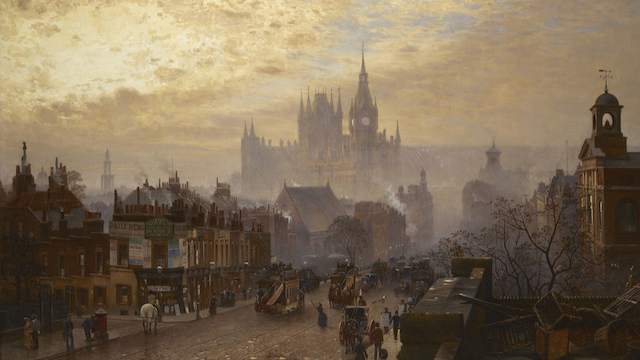October 14, 1900: Selden was chased across the moor by Watson and Sir Henry. [HOUN]
October 14, 1900: Watson and Sir Henry saw Holmes’s outline against the moor. [HOUN]
October 14, 1900: Sir Henry learned that Selden was Mrs Barrymore’s brother. [HOUN]
On October 13th…
October 13, 1900: At 2 a.m., Watson watched Barrymore signal to Selden. [HOUN]
October 13, 1900: Watson watched the meeting on the moor of Sir Henry and Beryl Stapleton. [HOUN]
October 13, 1900: Watson wrote his first report to Holmes. [HOUN]
On October 11th…
October 11, 1900: Dr Mortimer had lunch with Watson and Sir Henry. [HOUN]
On October 2nd…
October 2, 1879: Holmes discovered the body of Brunton and identified the crown of Charles I. [MUSG]
October 2, 1900: Stapleton showed Watson and Sir Henry the site of the legend. [HOUN]
On October 1st…
October 1, 1879: Rachel Howell disappeared. [MUSG]
October 1, 1900: Stapleton visited Baskerville Hall. [HOUN]
On September 30th…
September 30, 1889: Mary Sutherland wrote her stepfather about her impending marriage. [IDEN]
September 30, 1900: Watson walked to Grimpen and met both of the Stapletons. [HOUN]
On September 29th…
September 29, 1900: Watson and Sir Henry Baskerville left from Paddington Station. [HOUN]
On September 26th…
September 26, 1879: At 2:00 am, Reginald Musgrave found Brunton reading the family ritual. [MUSG]
This is one of my favorite cases. I love the family ritual. It appeals to me, “the man who is half a boy”.
September 26, 1900: An anonymous warning letter to Sir Henry Baskerville arrived at the Northumberland Hotel. [HOUN]
September 26, 1902: The Morning Post announced the de Merville-Gruner marriage would not take place. [ILLU]
On September 25th…
September 25, 1900: Dr Mortimer called at 221B. [HOUN]
September 25, 1900: Sir Henry Baskerville arrived at Houston Station. [HOUN]
Dr. Watson’s Pictures of Devonshire Countryside [HOUN]
There are no events on file for the rest of the month. I would like to leave you with the following Writing. It was written by a Sherlockian of Note who co-founded the only Scion society recognized by the Baker Street Irregulars in a nursing home. Known as Inspector Baynes in his postings he was Jody Baker in real life. His postings and his gazettes he published are really some of the best around.. I will post some more about Jody, his wonderful Sherlockian wife, his soulmate. But now here is his incomparable style.
Dr. Watson’s Pictures of Devonshire Countryside [HOUN]
Dr. Watson, with pen for a brush and his words for his paints,
pictures for us vivid landscapes of the Devonshire countryside.
>>>>>>>>>>>>>>>
“The journey was a swift and pleasant one …. In a very few hours the
brown earth had become ruddy, the brick had changed to granite, and
red cows grazed in well-hedged fields where the lush grasses and more
luxuriant vegetation spoke of a richer, if a damper, climate.”
*******
“Over the green squares of the fields and the low curve of a wood
there rose in the distance a gray, melancholy hill, with a strange
jagged summit, dim and vague in the distance, like some fantastic
landscape in a dream. “
*******
“The wagonette swung round into a side road, and we curved upward
through deep lanes worn by centuries of wheels, high banks on either
side, heavy with dripping moss and fleshy hart’s-tongue ferns.
Bronzing bracken and mottled bramble gleamed in the light of the
sinking sun. Still steadily rising, we passed over a narrow granite
bridge and skirted a noisy stream which gushed swiftly down, foaming
and roaring amid the gray boulders. Both road and stream wound up
through a valley dense with scrub oak and fir.”
>>>>>>>>>>>>>>>
Those Hounds, among us, who think of Watson as a dunce or a dullard
(as depicted by Nigel Bruce, in days of yore) may want to pause and
reflect upon Watson’s writings.Respectfully,
Inspector Baynes.
So on to September my dear Watsonians, Ron aka Chips
On May 5th…
May 5, 1900: Sir Charles Baskerville died (HOUN)
May 5, 1902: John Mason found part of a mummy dug up from the crypt (SHOS)
On October 19th…
October 19, 1900: Holmes and Watson shot and killed the Hound of the Baskervilles.
Jack Stapleton perished in the Grimpen Mire. (HOUN)
October 19, 1889: The Red Headed League was dissolved. (REDH)
Holmes captured John Clay. (REDH)
On October 18th…
October 18, 1900: Watson visited Laura Lyons in Coombe Tracy.
Holmes found Watson waiting for him in the stone hut on the moor. (HOUN)
On October 17th…
October 17, 1900: Watson learned that L.L. was Laura Lyons. (HOUN)
On October 16th…
October 16, 1900: Barrymore reported to Sir Henry that Sir Charles Baskerville had received a letter from L.L. (HOUN)
On October 15th…
October 15, 1900: Watson wrote his second report to Holmes. (HOUN)
On October 14th…
October 14, 1900: Seldon was chased across the moor by Watson and Sir Henry.
Watson and Sir Henry saw Holmes’s outline against the moor.
Sir Henry learned that Seldon was Barrymore’s brother. (HOUN)
On October 13th…
October 13, 1900: At 2am, Watson watched Barrymore signal to Seldon.
Watson watched the meeting on the moor of Sir Henry and Beryl Stapleton.
Watson wrote his first report to Holmes. (HOUN)
On October 11th…
October 11, 1900: Dr. Mortimer had lunch with Watson and Sir Henry. (HOUN)
On October 2nd…
October 2, 1900: Stapleton showed Watson and Sir Henry the site of the legend. (HOUN)
October 2, 1879: Holmes discovered the body of Brunton and identified the crown of Charles the first. (MUSG)
